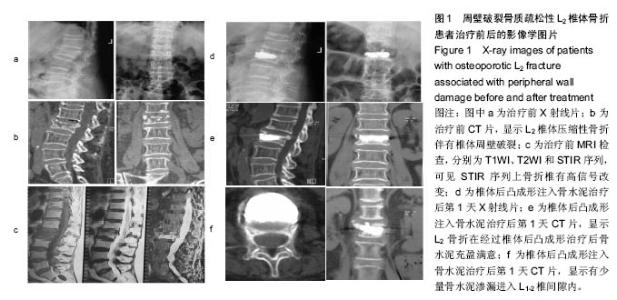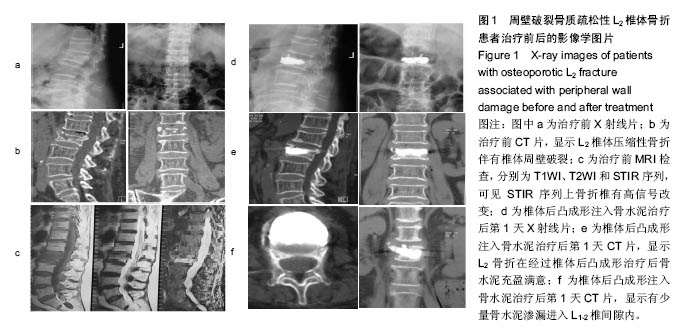Chinese Journal of Tissue Engineering Research ›› 2016, Vol. 20 ›› Issue (47): 7076-7082.doi: 10.3969/j.issn.2095-4344.2016.47.012
Previous Articles Next Articles
Kyphoplasty with bone cement repairs osteoporotic thoracolumbar vertebral fractures associated with peripheral wall damage: a 2-year follow-up
- Department of Orthopaedics, the First Affiliated Hospital of Soochow University, Suzhou 215006, Jiangsu Province, China
-
Received:2016-10-15Online:2016-11-18Published:2016-11-18 -
Contact:Yang Hui-lin, M.D., Chief physician, Professor, Doctoral supervisor, Department of Orthopaedics, the First Affiliated Hospital of Soochow University, Suzhou 215006, Jiangsu Province, China -
About author:Sun Zhi-yong, Master, Attending physician, Department of Orthopaedics, the First Affiliated Hospital of Soochow University, Suzhou 215006, Jiangsu Province, China -
Supported by:the Foundation of Jiangsu Provincial Clinical Medical Research Center, No. BL2012004; the National Natural Science Foundation of China, No. 81301646
CLC Number:
Cite this article
Sun Zhi-yong, Qian Zhong-lai, Zhu Xiao-yu, Chen Kang-wu, Pi Bin, Yang Hui-lin.
share this article
| [1]李宁华,区品中,朱汉民,等中国部分地区中老年人群原发骨质疏松症患病率研究[J].中华骨科杂志, 2002,115(5): 773-775. [2]Tutton SM,Pflugmacher R,Davidian M,et al. KAST Study: The Kiva System As a Vertebral Augmentation Treatment-A Safety and Effectiveness Trial: A Randomized, Noninferiority Trial Comparing the Kiva System With Balloon Kyphoplasty in Treatment of Osteoporotic Vertebral Compression Fractures.Spine (Phila Pa 1976).2015;40:865-875. [3]Niu J,Song D,Zhou H,et al.Percutaneous Kyphoplasty for the Treatment of Osteoporotic Vertebral Fractures with Intravertebral Fluid or Air: A Comparative Study. Clin Spine Surg.2016. [Epub ahead of print] [4]Wang CH,Ma JZ,Zhang CC,et al.Comparison of high-viscosity cement vertebroplasty and balloon kyphoplasty for the treatment of osteoporotic vertebral compression fractures.Pain Physician. 2015;18: E187-194. [5]Zhou J,Zhang Z,Huasong M,et al.Clinical evaluation of Crosstrees pod kyphoplasty in the treatment of osteoporotic vertebral compression fractures. Acta Orthop Belg.2013; 79:451-456. [6]Spross C,Aghayev E,Kocher R,et al.Incidence and risk factors for early adjacent vertebral fractures after balloon kyphoplasty for osteoporotic fractures: analysis of the SWISSspine registry.Eur Spine J. 2014;23:1332-1338. [7]Gu CN,Brinjikji W,Evans AJ,et al.Outcomes of vertebroplasty compared with kyphoplasty: a systematic review and meta-analysis.J Neurointerv Surg.2016; 8:636-642. [8]Wang GY,Zhang CC,Ren K,et al.Treatment of vertebral body compression fractures using percutaneous kyphoplasty guided by a combination of computed tomography and C-arm fluoroscopy with finger-touch guidance to determine the needle entry point.Genet Mol Res.2015;14:1546-1556. [9]Riesner HJ,Kiupel K,Lang P,et al.Clinical Relevance of Cement Leakage after Radiofrequency Kyphoplasty vs. Balloon Kyphoplasty: A Prospective Randomised Study. Z Orthop Unfall.2016;154:370-376. [10]Saget M,Teyssedou S,Prebet R,et al.Acrylic kyphoplasty in recent nonosteoporotic fractures of the thoracolumbar junction: a prospective clinical and 3D radiologic study of 54 patients.J Spinal Disord Tech. 2014;27:E226-233. [11]Chitale A,Prasad S.An evidence-based analysis of vertebroplasty and kyphoplasty. J Neurosurg Sci. 2013; 57:129-137. [12]Sembrano JN,Yson SC,Polly DW Jr,et al.Comparison of nonnavigated and 3-dimensional image-based computer navigated balloon kyphoplasty.Orthopedics. 2015;38:17-23. [13]Zou J,Mei X,Gan M,et al.Is kyphoplasty reliable for osteoporotic vertebral compression fracture with vertebral wall deficiency?Injury.2010;41:360-364. [14]State Council of the People's Republic of China. Administrative Regulations on Medical Institution. 1994-09-01. [15]王根林,杨惠林,孟斌,等.椎体后凸成形术治疗骨质疏松性Kümmell’s 病[J].中国脊柱脊髓杂志, 2011,21(1): 46-49. [16]王根林,杨惠林,姜为民,等.球囊扩张椎体后凸成形术治疗骨质疏松性椎体骨折后骨坏死[J].中华外科杂志, 2010, 48(8):593-596 [17]Disch AC,Schmoelz W.Cement augmentation in a thoracolumbar fracture model: reduction and stability after balloon kyphoplasty versus vertebral body stenting.Spine (Phila Pa 1976).2014;39:E1147-1153. [18]Yang DH,Cho KH,Chung YS,et al.Effect of vertebroplasty with bone filler device and comparison with balloon kyphoplasty.Eur Spine J. 2014;23:2718-2725. [19]Zhao G,Liu X,Li F.Balloon kyphoplasty versus percutaneous vertebroplasty for treatment of osteoporotic vertebral compression fractures (OVCFs).Osteoporos Int.2016; 27:2823-2834. [20]Markmiller M.Percutaneous balloon kyphoplasty of malignant lesions of the spine: a prospective consecutive study in 115 patients.Eur Spine J. 2015;24:2165-2172. [21]Lee SK,Lee SH,Yoon SP,et al.Quality of Life Comparison between Vertebroplasty and Kyphoplasty in Patients with Osteoporotic Vertebral Fractures.Asian Spine J.2014;8: 799-803. [22]Niu JJ,Shen MJ,Meng B,et al.Percutaneous kyphoplasty for the treatment of osteoporotic thoracolumbar fractures with neurological deficit: radicular pain can mimic disc herniation.Int J Clin Exp Med.2014;7:2360-2364. [23]Yang HL,Zhao L,Liu J,et al.Changes of pulmonary function for patients with osteoporotic vertebral compression fractures after kyphoplasty. J Spinal Disord Tech. 2007;20(3):221-225. [24]Yu CW,Hsieh MK,Chen LH,et al.Percutaneous balloon kyphoplasty for the treatment of vertebral compression fractures.BMC Surg.2014;14:3. [25]Hubschle L,Borgstrom F,Olafsson G,et al.Real-life results of balloon kyphoplasty for vertebral compression fractures from the SWISSspine registry. Spine J.2014;14: 2063-2077. [26]Spalteholz M,Strasser E,Hantel T,et al.Prone position in balloon kyphoplasty leads to no secondary vertebral compression fractures in osteoporotic spine - a MRI study. GMS Interdiscip Plast Reconstr Surg DGPW. 2014;3:Doc17. [27]Capel C,Fichten A,Nicot B,et al.Should we fear cement leakage during kyphoplasty in percutaneous traumatic spine surgery? A single experience with 76 consecutive cases. Neurochirurgie.2014;60:293-298. [28]Cumming D,Pagonis T,Wood R.Posterior instrumentation after a failed balloon kyphoplasty in the thoracolumbar junction: a case report.J Med Case Rep.2014;8:189. [29]Sayari AJ,Liu Y,Cohen JR,et al.Trends in vertebroplasty and kyphoplasty after thoracolumbar osteoporotic fracture: A large database study from 2005 to 2012.J Orthop. 2015;12:S217-222. [30]Noriega DC,Ramajo RH,Lite IS,et al.Safety and clinical performance of kyphoplasty and SpineJack((R)) procedures in the treatment of osteoporotic vertebral compression fractures: a pilot, monocentric, investigator-initiated study.Osteoporos Int.2016; 27: 2047-2055. [31]Landham PR,Baker-Rand HL,Gilbert SJ,et al.Is kyphoplasty better than vertebroplasty at restoring form and function after severe vertebral wedge fractures? Spine J.2015;15:721-732. [32]Kanatli U,Ataoglu B,Ozer M,et al.Kyphoplasty for Intractable Pain Due to Glucocorticosteroid-induced Osteoporotic Vertebra Fracture of a 9-Year-Old Patient With Systemic Lupus Erythematosus: 8-Year Follow-up.J Pediatr Orthop.2015; 35:e55-59. [33]Molloy S,Sewell MD,Platinum J,et al.Is balloon kyphoplasty safe and effective for cancer-related vertebral compression fractures with posterior vertebral body wall defects?J Surg Oncol. 2016;113: 835-842. [34]Chen GD,Lu Q,Wang GL,et al.Percutaneous Kyphoplasty for Kummell Disease with Severe Spinal Canal Stenosis.Pain Physician.2015;18:E1021-1028 [35]吴子详,雷伟,马真胜,等.阶段注射法预防椎体成形术中骨水泥渗漏的实验研究[J].中国骨质疏松杂志, 2010,16(2): 96-99. [36]Van Meirhaeghe J,Bastian L,Boonen S,et al.A randomized trial of balloon kyphoplasty and nonsurgical management for treating acute vertebral compression fractures: vertebral body kyphosis correction and surgical parameters.Spine(Phila Pa 1976).2013; 38:971-983. [37]Xing D,Ma JX,Ma XL,et al.A meta-analysis of balloon kyphoplasty compared to percutaneous vertebroplasty for treating osteoporotic vertebral compression fractures. J Clin Neurosci.2013;20:795-803. [38]Huang Z,Zhang L.Treatment of osteoporotic vertebral ompressive fractures with percutaneous kyphoplasty and oral Zishengukang.J Tradit Chin Med. 2012;32: 561-564. [39]Wang E,Yi H,Wang M,et al.Treatment of osteoporotic vertebral compression fractures with percutaneous kyphoplasty: a report of 196 cases.Eur J Orthop Surg Traumatol.2013;23 Suppl 1:S71-75. [40]Li D,Huang Y,Yang H,et al.Jack vertebral dilator kyphoplasty for treatment of osteoporotic vertebral compression fractures.Eur J Orthop Surg Traumatol. 2014;24: 15-21. [41]Rollinghoff M,Zarghooni K,Zeh A,et al.Is there a stable vertebral height restoration with the new radiofrequency kyphoplasty? A clinical and radiological study. Eur J Orthop Surg Traumatol.2013;23:507-513. [42]Wu AM,Ni WF,Weng W,et al.Outcomes of percutaneous kyphoplasty in patients with intravertebral vacuum cleft.Acta Orthop Belg.2012;78: 790-795. [43]Korovessis P,Vardakastanis K,Repantis T,et al. Balloon kyphoplasty versus KIVA vertebral augmentation-- comparison of 2 techniques for osteoporotic vertebral body fractures: a prospective randomized study. Spine (Phila Pa 1976). 2013;38:292-299. [44]Schils F,Schoojans W,Struelens L.The surgeon's real dose exposure during balloon kyphoplasty procedure and evaluation of the cement delivery system: a prospective study. Eur Spine J.2013;22:1758-1764. [45]Yokoyama K,Kawanishi M,Yamada M,et al.In not only vertebroplasty but also kyphoplasty, the resolution of vertebral deformities depends on vertebral mobility. AJNR Am J Neuroradiol.2013;34:1474-1478. [46]Garcia-Fontan E,Blanco Ramos M,Obeso Carillo GA.Cement embolism during a kyphoplasty.Eur J Cardiothorac Surg.2013;44:183. [47]Zhang HT,Sun ZY,Zhu XY,et al.Kyphoplasty for the treatment of very severe osteoporotic vertebral compression fracture.J Int Med Res.2012;40:2394-2400. [48]Freude T,Konig B,Martetschlager F,et al.Safe surgical technique: cement-augmented pedicle screw instrumentation and balloon-guided kyphoplasty for a lumbar burst fracture in a 97-year-old patient.Patient Saf Surg.2013;7:3. [49]Aebli N,krebs J,Schwenke D,et al.Pressurization of vertebral bodies during vertebroplasty causes cardiovascular complications:an experimental study in sheep . Spine(Phila Pa 1976).2003;28(14):1513-1519. [50]Giannotti S,Carmassi F,Bottai V,et al.Comparison of 50 vertebral compression fractures treated with surgical (kyphoplasty) or non surgical approach. Clin Cases Miner Bone Metab.2012;9:184-186. [51]Yang H,Liu T,Zhou J,et al.Kyphoplasty versus vertebroplasty for painful osteoporotic vertebral compression fractures-which one is better? A systematic review and meta-analysis.Int J Spine Surg.2013;7:e45-57. [52]Chen H,Tang P,Zhao Y,et al.Unilateral versus bilateral balloon kyphoplasty in the treatment of osteoporotic vertebral compression fractures.Orthopedics.2014;37: e828-835. [53]Hulme PA,Krebs J,Ferguson SJ,et al.Vertebroplasty and kyphoplasty:a systematic review of 69 clinical studies,Spine (Phila Pa 1 976).2006;31(17): 1983-2001. [54]Lee MJ,Dumonski M,Cahill P,et al.Percutaneous treatment of vertebral compression fractures:a meta-analysis of complications.Spine(Phila Pa 1 976). 2009;34(11):1228-1232. |
| [1] | Zhang Tongtong, Wang Zhonghua, Wen Jie, Song Yuxin, Liu Lin. Application of three-dimensional printing model in surgical resection and reconstruction of cervical tumor [J]. Chinese Journal of Tissue Engineering Research, 2021, 25(9): 1335-1339. |
| [2] | Zeng Yanhua, Hao Yanlei. In vitro culture and purification of Schwann cells: a systematic review [J]. Chinese Journal of Tissue Engineering Research, 2021, 25(7): 1135-1141. |
| [3] | Xu Dongzi, Zhang Ting, Ouyang Zhaolian. The global competitive situation of cardiac tissue engineering based on patent analysis [J]. Chinese Journal of Tissue Engineering Research, 2021, 25(5): 807-812. |
| [4] | Wu Zijian, Hu Zhaoduan, Xie Youqiong, Wang Feng, Li Jia, Li Bocun, Cai Guowei, Peng Rui. Three-dimensional printing technology and bone tissue engineering research: literature metrology and visual analysis of research hotspots [J]. Chinese Journal of Tissue Engineering Research, 2021, 25(4): 564-569. |
| [5] | Chang Wenliao, Zhao Jie, Sun Xiaoliang, Wang Kun, Wu Guofeng, Zhou Jian, Li Shuxiang, Sun Han. Material selection, theoretical design and biomimetic function of artificial periosteum [J]. Chinese Journal of Tissue Engineering Research, 2021, 25(4): 600-606. |
| [6] | Liu Fei, Cui Yutao, Liu He. Advantages and problems of local antibiotic delivery system in the treatment of osteomyelitis [J]. Chinese Journal of Tissue Engineering Research, 2021, 25(4): 614-620. |
| [7] | Li Xiaozhuang, Duan Hao, Wang Weizhou, Tang Zhihong, Wang Yanghao, He Fei. Application of bone tissue engineering materials in the treatment of bone defect diseases in vivo [J]. Chinese Journal of Tissue Engineering Research, 2021, 25(4): 626-631. |
| [8] | Zhang Zhenkun, Li Zhe, Li Ya, Wang Yingying, Wang Yaping, Zhou Xinkui, Ma Shanshan, Guan Fangxia. Application of alginate based hydrogels/dressings in wound healing: sustained, dynamic and sequential release [J]. Chinese Journal of Tissue Engineering Research, 2021, 25(4): 638-643. |
| [9] | Chen Jiana, Qiu Yanling, Nie Minhai, Liu Xuqian. Tissue engineering scaffolds in repairing oral and maxillofacial soft tissue defects [J]. Chinese Journal of Tissue Engineering Research, 2021, 25(4): 644-650. |
| [10] | Xing Hao, Zhang Yonghong, Wang Dong. Advantages and disadvantages of repairing large-segment bone defect [J]. Chinese Journal of Tissue Engineering Research, 2021, 25(3): 426-430. |
| [11] | Zhong Yuanming, Wan Tong, Zhong Xifeng, Wu Zhuotan, He Bingkun, Wu Sixian. Meta-analysis of the efficacy and safety of percutaneous curved vertebroplasty and unilateral pedicle approach percutaneous vertebroplasty in the treatment of osteoporotic vertebral compression fracture [J]. Chinese Journal of Tissue Engineering Research, 2021, 25(3): 456-462. |
| [12] | Feng Guancheng, Fang Jianming, Lü Haoran, Zhang Dongsheng, Wei Jiadong, Yu Bingbing. How does bone cement dispersion affect the early outcome of percutaneous vertebroplasty [J]. Chinese Journal of Tissue Engineering Research, 2021, 25(22): 3450-3457. |
| [13] | Chen Siqi, Xian Debin, Xu Rongsheng, Qin Zhongjie, Zhang Lei, Xia Delin. Effects of bone marrow mesenchymal stem cells and human umbilical vein endothelial cells combined with hydroxyapatite-tricalcium phosphate scaffolds on early angiogenesis in skull defect repair in rats [J]. Chinese Journal of Tissue Engineering Research, 2021, 25(22): 3458-3465. |
| [14] | Wang Hao, Chen Mingxue, Li Junkang, Luo Xujiang, Peng Liqing, Li Huo, Huang Bo, Tian Guangzhao, Liu Shuyun, Sui Xiang, Huang Jingxiang, Guo Quanyi, Lu Xiaobo. Decellularized porcine skin matrix for tissue-engineered meniscus scaffold [J]. Chinese Journal of Tissue Engineering Research, 2021, 25(22): 3473-3478. |
| [15] | Mo Jianling, He Shaoru, Feng Bowen, Jian Minqiao, Zhang Xiaohui, Liu Caisheng, Liang Yijing, Liu Yumei, Chen Liang, Zhou Haiyu, Liu Yanhui. Forming prevascularized cell sheets and the expression of angiogenesis-related factors [J]. Chinese Journal of Tissue Engineering Research, 2021, 25(22): 3479-3486. |
| Viewed | ||||||
|
Full text |
|
|||||
|
Abstract |
|
|||||



